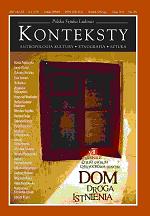Muzeum – mauzoleum – panteon. Sakralizacja ostateczna domu artysty po romantyzmie
Museum-Mausoleum-Pantheon. The Ultimate Post-Romantic Sacralisation of the Artist’s Home
Author(s): Andrzej PieńkosSubject(s): Anthropology
Published by: Instytut Sztuki Polskiej Akademii Nauk
Keywords: anthropology; home
Summary/Abstract: When the cult of the artist reached its apogee during the Romantic era, the microcosmos of the home be- came afrequent part of archetypical associations: acastle with aturret, an armoury, amagnate’s palace with gardens full of sculptures and fountains, acha- pel, etc. Such associations situate artists as the spiri- tual heirs of feudal lords, ruling over agiven territory, knights battling for the faith and honour, or priests guarding over spiritual order. Domes, 'knightly' ce- ilings of 'armouries' and stained glass windows not on- ly granted splendour to the seats of the artists, but brought to mind asequence of associations with the olden days and the sphere of the sacrum. Some artists settled down in the direct proximity of asacral buil- ding (L. Poliaghi’s 'Sacro Monte' in Varese) or direc- tly on the site (A. Munthe on Capri, I. Zuloaga in Zu- maya, M. Denis in Saint-Germain-en-Laye). Sacral descriptions of their residences were used outright by, i. a. W. Scott and G. D’Annunzio. Historical models best expressed the glorification of the artist when assisted by eschatological references. Special proof of acult was the custom, increasingly universal in the nineteenth century, of displaying dead writers and artists in their studios, in the manner of the pompa funebris of the rulers of old (B. Thorvaldsen, A. Wiertz, H. Makart, F. von Stuck). The body of the sculptor V. Vela was on view amongst his masterpie- ces, comprising an exposition of his oeuvre featured in an octagonal hall at the artist’s home in Ligornetto. This installation of apost-Romantic cult of the artist in the central, domed hall of the 'Vela Pantheon', which brought to mind sacral (as well as ancient and Christian!) connotations, lasted for two days. The ar- tist’s home and studio became his mausoleum, albeit ephemeral, while the catafalque was depicted on Ve- la’s tombstone in the Ligornetto cemetery. The house, erected on ahillock and surrounded with an Italian garden maintained in the Renaissance sty- le, designed on the ideal ground plan of asquare and with the an inscribed central domed hall, served both as ahome-atelier and as Vela’s museum. Finally, it be- came his monument. In his home village of Possagno, A. Canova, the ini- tiator of transforming the Roman Pantheon into amonument of great artists, built for himself achurch-monument containing his grave. The return of the body (diminished, since certain 'relics' were bu- ried separately in Venice and Rome as asymbol of the veneration of the artist) and the most private frag- ment of his oeuvre rendered the small locality of Po- ssagno the centre of acult. The Thorvaldsen Museum in Copenhagen, which brings forth numerous associations with temples, urns and sepulchres, is also the sculptor’s mausoleum. The sacralisation of museum space, reconstructing the ho- me, life and works of the artist, was ultimately accen- tuated by placing an authentic sepulchre of Tho
Journal: Konteksty
- Issue Year: 2010
- Issue No: 02-03
- Page Range: 207-213
- Page Count: 7
- Language: Polish
- Content File-PDF

